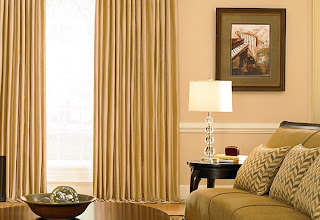 |
| A matte beige wall, cream satin trim makes a monochromatic scheme so a small room seems larger. |
1) What is the function of the room? When deciding which colors should be in a room, think about its function. A gathering space may require different colors than a peaceful retreat. Since color can energize a room, close it up for warmth and intimacy, and even create a calming atmosphere, it will set the tone for that space. You can define spaces with color, or join them. Keeping colors similar in joined spaces will make them flow well, and using different colors can create separation and even the appearance of larger space. Bright, rich colors like fire engine red, lime green, and tangerine energize a space. Colors like pale blue, seafoam green, and taupe are soft and calming. Many paint companies have color viewers on line where you can upload a photo of your room (or use one of theirs) and experiment with different color palettes and combinations.
2) Create a color focal point. This is a great way to bring drama into a room. When you want to use bolder colors, a focal point makes it easy to do. Some ideas include, fireplace walls, large window walls, a niche wall; in rooms with multiple openings (doors and windows) the solid wall can be a focal point. When using a single, striking hue on a focal wall, you need to balance with repeating that color in accessories in other areas of the room. If bold is too dramatic for you, try accenting shelves, niches, and moldings instead.
 |
| A rich terra cotta accent wall in a room full of windows makes it cozy and warm. |
4) Choose the right white. With hundreds of tints of white, this is a challenge. Every white has an undertone...a hint of blue, yellow, pink etc... The undertone should complement the other colors in the space - wood, fabrics, carpeting. Using warm undertones of white for trim is best in rooms painted in warm hues; cool whites are better in rooms with cool wall colors. Comparing a sheet of white paper to the paint swatches you like, can make the undertone more readily apparent.
 |
| White on white is elegant and dramatic. |
5) What is sheen and how do you select it? Sheen is the level of shine which affects the amount of light reflected from a painted surface. Flat sheen has no shine and is best for ceilings and walls that are damaged since it hides imperfections in the surface. Matte is the next sheen level. It's great for high traffic areas and touch-up is easy. Eggshell is a mid-level sheen which offers a soft glow. Pearl has a slightly higher sheen level and is great for kitchens and baths walls. Semi-gloss is a very durable shine and is great to use on surfaces that require repeated cleaning...moldings, trims and doors. It is wonderful to see the contrast of semi-gloss trim on a matte wall. High-gloss is not often used anymore, and is the highest sheen level; used on woodwork, doors, base and crown and other moldings in older, traditional homes.